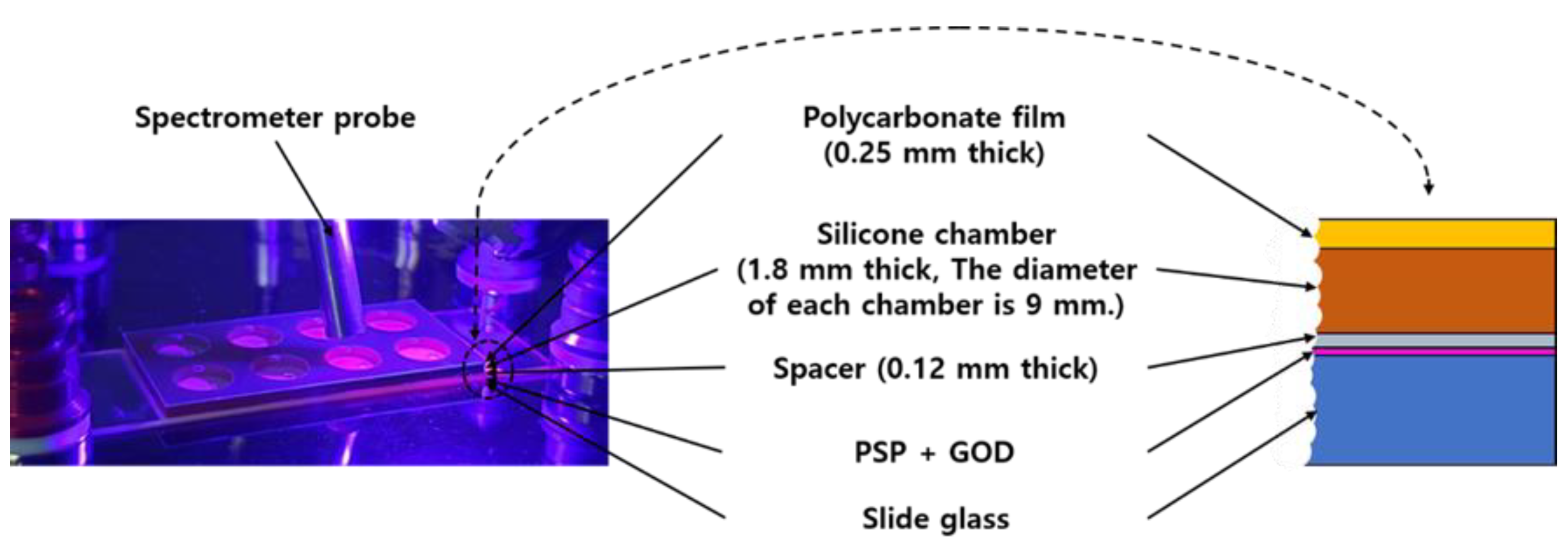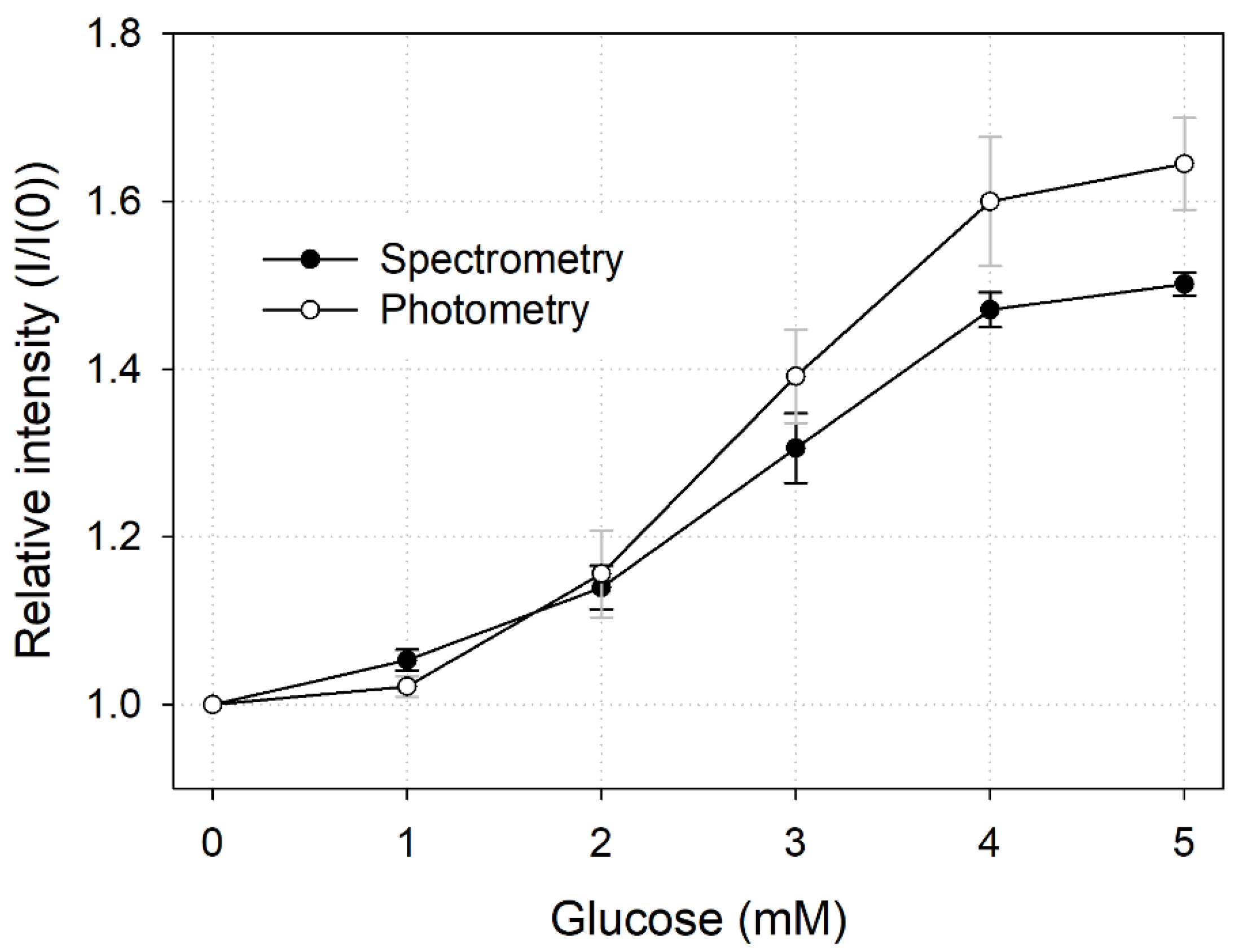Optical Glucose Sensor Using Pressure Sensitive Paint
Abstract
:1. Introduction
- (1)
- Design and fabrication of glucose sensor film using PSP;
- (2)
- Spectrum analysis of the output optical signal of the manufactured glucose sensor by spectrometry;
- (3)
- Development of a quantitative analysis method through color image analysis (photometry) of glucose sensor;
- (4)
- Comparison of glucose quantification methods.
2. Materials and Methods
2.1. Glucose Sensor Manufacturing
2.1.1. Commercial PSP for Glucose Sensor
2.1.2. Glucose Oxidase Enzyme Layer
2.1.3. Structure of the Glucose Sensor
2.2. Glucose Quantification
2.2.1. Measurement Fixture
2.2.2. Spectrometric and Photometric Measurements
3. Results and Discussion
3.1. Spectrum Analysis of the Output Optical Signal of the Glucose Sensor: Spectrometry
3.2. Image Analysis of the Glucose Sensor: Photometry
3.3. Comparison of Quantitication Results of Each Analysis Method
4. Conclusions
Funding
Institutional Review Board Statement
Informed Consent Statement
Data Availability Statement
Conflicts of Interest
References
- Vashist, S.K.; Zheng, D.; Al-Rubeaan, K.; Luong, J.H.T.; Sheu, F. Technology behind commercial devices for blood glucose monitoring in diabetes management: A review. Anal. Chim. Acta 2011, 703, 124–136. [Google Scholar] [CrossRef] [PubMed]
- Cote, G.L.; Cameron, B.D. Noninvasive polarimetric measurement of glucose in cell culture media. J. Biomed. 1997, 2, 275–281. [Google Scholar] [CrossRef] [PubMed]
- Gong, P.; Li, X.; Zhou, X.; Zhang, Y.; Chen, N.; Wang, S.; Zhang, S.; Zhao, Y. Optical fiber sensors for glucose concentration measurement: A review. Opt. Laser Technol. 2021, 139, 106981. [Google Scholar] [CrossRef]
- Hwang, D.; Lee, S.; Seo, M.; Chung, T.D. Recent advances in electrochemical non-enzymatic glucose sensors—A review. Anal. Chim. Acta 2018, 1033, 1–34. [Google Scholar] [CrossRef] [PubMed]
- Teymourian, H.; Barfidokht, A.; Wang, J. Electrochemical glucose sensors in diabetes management: An updated review (2010–2020). Chem. Soc. Rev. 2020, 49, 7671–7709. [Google Scholar] [CrossRef] [PubMed]
- Cappon., G.; Vettoretti, M.; Sparacino, G.; Facchinetti, A. Continuous glucose monitoring sensors for diabetes management: A review of technologies and applications. Diabetes Metab. J. 2019, 43, 383–397. [Google Scholar] [CrossRef] [PubMed]
- Yadav, J.; Rani, A.; Singh, V.; Murani, B.M. Prospects and limitations of non-invasive blood glucose monitoring using near-infrared spectroscopy. Biomed. Signal Process. 2015, 18, 214–227. [Google Scholar] [CrossRef]
- Pandey, R.; Paidi, S.K.; Valdez, T.A.; Zhang, C.; Spegazzini, N.; Dasari, R.R.; Barman, I. Noninvasive monitoring of blood glucose with Raman spectroscopy. Acc. Chem. Res. 2017, 50, 264–272. [Google Scholar] [CrossRef] [PubMed] [Green Version]
- McNichols, R.J.; Cote, G.L. Optical glucose sensing in biological fluids: An overview. J. Biomed. Opt. 2000, 5, 5–16. [Google Scholar] [CrossRef]
- Brown, J.Q.; Srivastava, R.; McShane, M.J. Encapsulation of glucose oxidase and an oxygen-quenched fluorophore in polyelectrolyte-coated calcium alginate microspheres as optical glucose sensor systems. Biosens. Bioelectron. 2005, 21, 212–216. [Google Scholar] [CrossRef] [PubMed]
- Wolfbeis, O.S.; Oehme, I.; Papkovskaya, N.; Klimant, I. Sol-gel based glucose biosensors employing optical oxygen transducers, and a method for compensating for variable oxygen background. Biosens. Bioelectron. 2000, 15, 69–76. [Google Scholar] [CrossRef]
- Su, F.; Zhang, L.; Kong, X.; Lee, F.; Tian, Y.; Meldrum, D.R. Ratiometric glucose sensing based on fluorescent oxygen films and glucose oxidase. Sens. Biosens. Res. 2017, 14, 1–6. [Google Scholar] [CrossRef]
- Schaffar, B.P.; Wolfbeis, O.S. A fast responding fiber optic glucose biosensor based on an oxygen optrode. Biosens. Bioelectron. 1990, 5, 137–148. [Google Scholar] [CrossRef]
- Moreno-Bondi, M.C.; Wolfbeis, O.S.; Leiner, M.J.; Schaffar, B.P. Oxygen optrode for use in a fiber-optic glucose biosensor. Anal. Chem. 1990, 62, 2377–2380. [Google Scholar] [CrossRef]
- Li, L.; Walt, D.R. Dual-analyte fiber-optic sensor for the simultaneous and continuous measurement of glucose and oxygen. Anal. Chem. 1995, 67, 3746–3753. [Google Scholar] [CrossRef]
- Sant, Y.L.; Merienne, M.C. Surface pressure measurements by using pressure-sensitive paints. Aerosp. Sci. Technol. 2005, 9, 285–299. [Google Scholar] [CrossRef]
- McLachlan, B.G.; Bell, J.H. Pressure-sensitive paint in aerodynamic testing. Exp. Therm. Fluid Sci. 1995, 10, 470–485. [Google Scholar] [CrossRef]
- UniCoat Pressure Sensitive Paint. Available online: https://innssi.com/wp-content/uploads/Pressure_Sensitive_Paint/UniCoat/Documentation/UniCoat-PSP-UNC-12-Data-Sheet.pdf (accessed on 24 May 2021).
- Park, J.; Kim, C.; Choi, M. Oxidase-coupled amperometric glucose and lactate sensors with integrated electrochemical actuation system. IEEE Trans. Instrum. Meas. 2006, 55, 1348–1355. [Google Scholar] [CrossRef]







| Source | Response Time | Linear Analytical Range |
|---|---|---|
| This research | 2 min. | 0.37–4 mM |
| Reference [12] | 2 min. | 0–5 mM 1 |
| Reference [13] | 8–60 s. | 0.01–2 mM |
| Reference [14] | 6 min. | 0.06–1 mM |
| Reference [15] | 9–28 s. | 0.6–20 mM 2 |
Publisher’s Note: MDPI stays neutral with regard to jurisdictional claims in published maps and institutional affiliations. |
© 2021 by the author. Licensee MDPI, Basel, Switzerland. This article is an open access article distributed under the terms and conditions of the Creative Commons Attribution (CC BY) license (https://creativecommons.org/licenses/by/4.0/).
Share and Cite
Park, J. Optical Glucose Sensor Using Pressure Sensitive Paint. Sensors 2021, 21, 4474. https://doi.org/10.3390/s21134474
Park J. Optical Glucose Sensor Using Pressure Sensitive Paint. Sensors. 2021; 21(13):4474. https://doi.org/10.3390/s21134474
Chicago/Turabian StylePark, Jongwon. 2021. "Optical Glucose Sensor Using Pressure Sensitive Paint" Sensors 21, no. 13: 4474. https://doi.org/10.3390/s21134474
APA StylePark, J. (2021). Optical Glucose Sensor Using Pressure Sensitive Paint. Sensors, 21(13), 4474. https://doi.org/10.3390/s21134474






